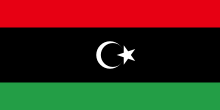Flag of Libya

The flag of Libya (Template:Lang-ar) (adopted on November 11, 1977) consists of a green field. It is the only national flag in the world with just one colour and no design, insignia, or other details.[1] It was designed by Libyan leader Muammar al-Gaddafi.[2]
The flag of the independent kingdom was red, black, and green with a crescent and star in the center. After the Libyan revolution of 1969, the flag was changed to the Arab Liberation Flag of horizontal red, white, and black bands. In 1971 Libya joined the Federation of Arab Republics with Egypt and Syria, which used a similar flag with a hawk emblem in the center and the name of the country beneath it. When Libya left the Federation in 1977, the new plain green flag was adopted. Green reflects the people's devotion to Islam, and is also the national color of Libya.

Libya is currently subject to a mass uprising against the rule of Muammar al-Gaddafi. In areas held by the Libyan opposition, the 1951 to 1969 flag is in use. This flag is also flown by Libyan diplomatic missions that have defected from the Gaddafi government.[2] [failed verification][3]
History
- 1918–1923
The short-lived Tripolitanian Republic in western Libya had its own flag, which had a light blue field and a green palm tree in the center, with a white star on top of it.[4]
- 1951–1969
The flag of the Kingdom of Libya was adopted when Libya gained independence in 1951 from Italy. It consisted of a white crescent-and-star on a triband red-black-green design, with the central black band being twice the width of the outer bands. Today, the former flag is still used by monarchists and the Libyan opposition abroad. The design was based on the Senussi flag, which consisted of a black field and crescent-and-star design. It was unanamously voted on by all the different cities in Libya. This flag is used by some of the protestors taking part in the 2011 uprising against the rule of Muammar al-Gaddafi.[5][6]
- 1969–1972
Following the 1969 Libyan Revolution, the official name of Libya was changed to the Libyan Arab Republic, and the flag was replaced by the Pan-Arab red-white-black tricolor of the Arab Liberation Flag, first flown after the Egyptian Revolution of 1952 (which also formed the basis of the flags of Egypt, Iraq, Syria, and Yemen).
- 1972–1977
In 1972 when Libya joined the Federation of Arab Republics, the flag of the Federation of Arab Republics was adopted (briefly linking Libya to Egypt and Syria). It featured a golden hawk (the "Hawk of Qureish"), holding a scroll with the Arabic name of the Federation.[7]
- 1977–
On March 8, 1977 Libya's official name was changed to the Great Socialist People's Libyan Arab Jamahiriya, and on November 11, 1977 the flag was changed to the current all-green design in reaction to Anwar Sadat's visit to Israel. Green is the traditional color of Islam, the state religion. It is also symbolic of Gaddafi's "Green Revolution".
Flag history
-
Kingdom of Libya
(1951–1969) -
Libyan Arab Republic (1969–1972)
-
Libyan Arab Republic within the Federation of Arab Republics (1972–1977)
-
Great Socialist People's Libyan Arab Jamahiriya (1977-2011) Flown in areas under control of the Gaddafi government
-
Flag flown in areas controlled by the Libyan opposition
(2011–)
See also
References
- ^ "Libya Flag". Retrieved December 12, 2009.
- ^ a b "Staff of Libyan consulate in Egypt lower flag". Reuters.
- ^ http://www.bbc.co.uk/news/world-12556524
- ^ "World Statemen-Libya". Retrieved December 12, 2009.
- ^ Janathan S. Landay, Warren P. Strobel and Arwa Ibrahim (18 February 2011). "Violent repression of protests rocks Libya, Bahrain, Yemen". The Kansas City Star. Retrieved 19 February 2011.
- ^ Mark Tran (17 February 2011). "Bahrain in crisis and Middle East protests – live blog". The Guardian. Retrieved 19 February 2011.
- ^ Smith, Whitney; Buhrer, Emil (1975). Flags Through the Ages and Across the World. New York, New York: McGraw-Hill. p. 361. ISBN 978-0-07-059093-7.
{{cite book}}: Check|isbn=value: checksum (help)




